Selling a product online is all the rage right now, especially after the COVID-19 pandemic.
And the growth of the eCommerce industry is not going to slow down anytime soon.
According to research, there are over 12 million eCommerce websites globally, with more and more being launched daily.
The good news is that there are now several ways to start selling a product online in 2022.
For instance, you could use a marketplace such as eBay, Amazon, Etsy, etc. to start selling a product online.
Or, you can build an eCommerce store of your own to sell online products, and scale it as your business grows.
Unfortunately, the marketplace option offers limited scalability & profitability compared to the eCommerce store option.
So in this article, we will mainly focus on how to start selling a product online through the eCommerce route, and a little bit about the marketplace option in the end.
That said, let’s begin with the basics of selling a product online and move forward from there!
Basics of Selling a Product Online
Selling products online through an eCommerce store is more than just setting up an eCommerce website and uploading product images — it requires proper research, planning, marketing expertise, and a concrete strategy.
Moreover, selling a product online is not always as seamless as it may seem. The playground of eCommerce can present many challenges that can complicate the process of starting an eCommerce business.
On the other hand, however, the benefits of selling a product online outweigh the challenges involved.
That said, let’s quickly go through the five key benefits of selling products online.
Benefits of Selling Products Online
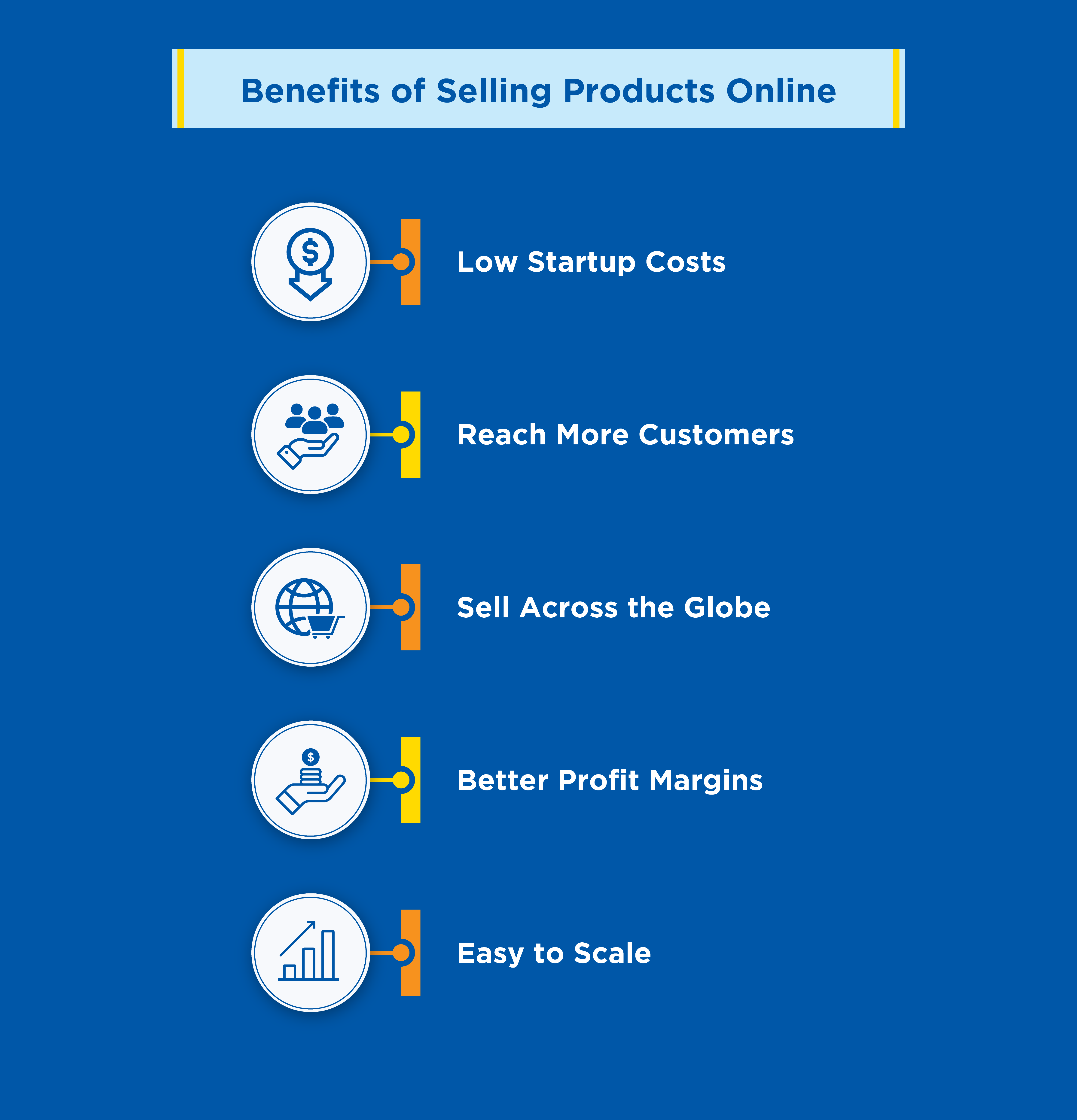
Low Startup Costs
Anyone who owns a physical retail store knows how expensive the costs associated with rent, utilities, and wages are.
But, when you launch an eCommerce store, you no longer have to deal with a landlord, pay utility bills, or incur ongoing expenses that come with running a brick-and-mortar store.
Sure, launching an eCommerce store requires money to create a website and accept online payments. But the startup cost is much cheaper when compared to the physical store.
Reach More Customers
Unlike brick-and-mortar stores, there are no barriers to reaching customers when you launch an eCommerce store. This is a great opportunity because online selling opens up the doors to a whole new set of customers.
It may cost a bit more to ship your products internationally. But online selling also boosts your customer reach and hence, sales & profits.
Sell Across the Globe
As we discussed just above, when you launch an eCommerce store, you can start selling your products all over the world. Your online store enables you to sell to your customers nationwide as well as internationally.
For example, let’s say that you sell electronic gadgets from your warehouse in London. Now, if you want to sell to customers in Europe, all you need is an eCommerce website to receive orders from them.
Better Profit Margins
Since an eCommerce store eliminates the overhead costs associated with a brick-and-mortar store, you can offer to sell your products online at a lower cost and still make a better profit.
This is possible because when you’re selling online products, your profit margins automatically increase. After all, the cost of running your eCommerce business is lower.
Easy to Scale
Because eCommerce is totally digital, it’s extremely easy to track your sales. This, in turn, can help to make better decisions about which of your products are doing well and which are not.
This helps to figure out which of your products are best-selling that will ultimately improve your bottom line.
That said, now that you’re aware of the benefits of selling products online, let’s move forward and learn how to get started.
How to Start Selling Products Online
Selling a product online may seem like a straightforward job — and it certainly can be, as long as you’ve set up everything correctly.
These are the steps you need to take to start selling your products online easily.
1. Prerequisites for Online Selling
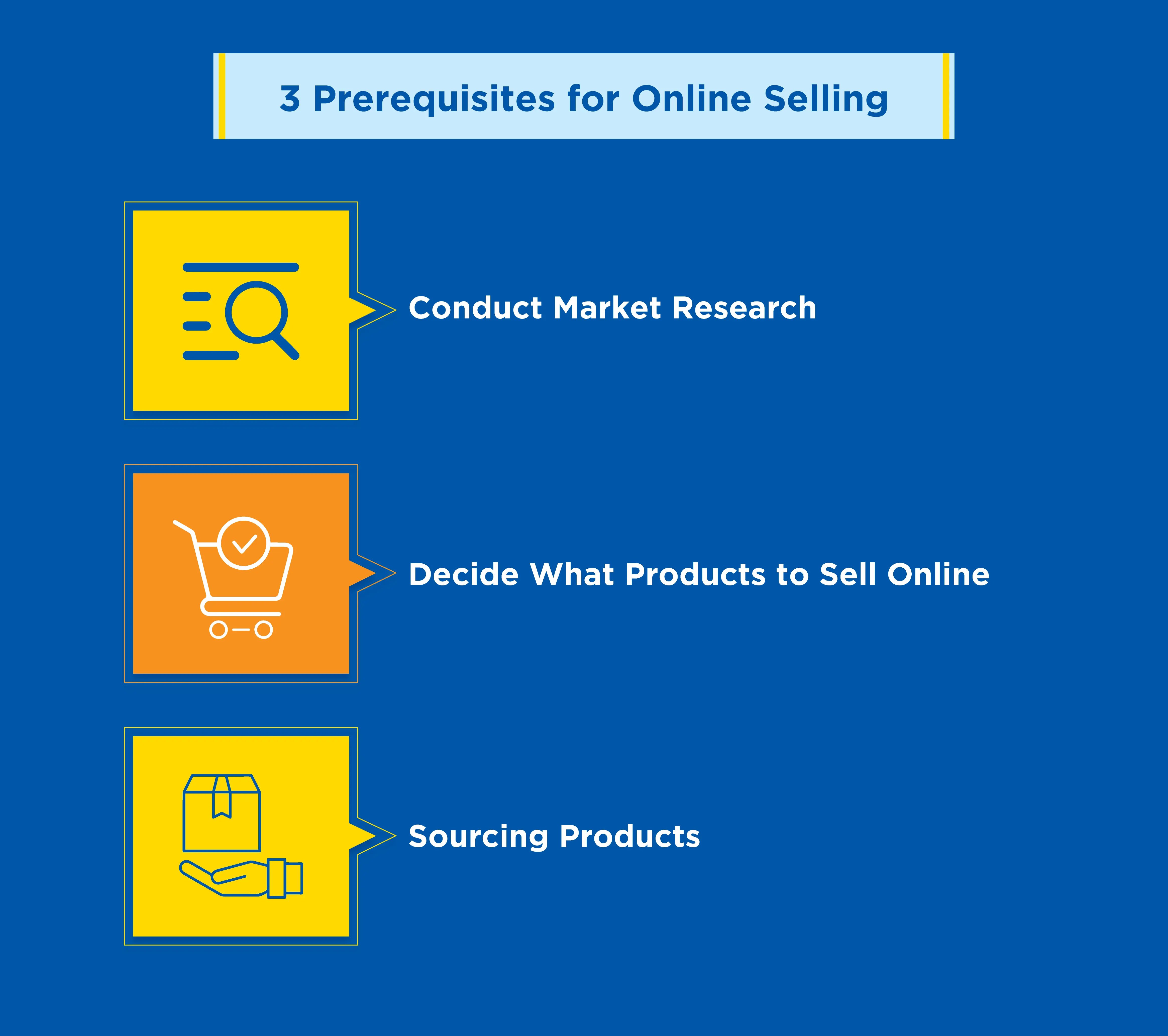
1.1 Conduct Market Research
The best thing about eCommerce is its low barrier of entry. Whether you run a small business or a large organisation, you can easily go digital with your business and join the eCommerce bandwagon.
However, the low barrier to entry also comes with a competitive market.
So, before deciding which products to sell online, conduct thorough research to identify which markets are over-saturated and which markets have the growth potential.
For this, you can leverage Google Ads Keyword Planner or Google Trends to see what products are trending right now and how big the market is.
Once you have identified online best-selling products, the next step is to decide what products to sell online.
1.2 Decide What Products to Sell Online
Deciding what products to sell online is one of the most critical aspects of this process. This is mainly because every other aspect of your eCommerce business will revolve around what products you’re selling in one way or another.
If you cannot choose what products to sell online, it is a good idea to consider selling trending products online.
While the competition for trending products is likely to be high, you can make pretty good profits if you join the wave early on.
1.3 Sourcing Products
There are three places from where most online sellers source their products:
- DIY Products - These are the products that you make yourself. DIY products are generally a bit expensive. They are also one of the highly-gratifying and in-demand products across the globe.
- Wholesale Products - Most traditional retail businesses buy items in bulk directly from a wholesaler or manufacturer and sell them at retail prices. You can easily find wholesale products to sell online from sites like Etsy Wholesale, Alibaba, and even eBay.
- Dropshipping Products - In the dropshipping model, you’re responsible for promoting the products and taking orders from customers, while your supplier is responsible for order fulfilment. Just like wholesale products, you can easily find dropshipping products from sites like Wholesale2B, Megagoods, AliExpress, and more.
2. Build an eCommerce Website
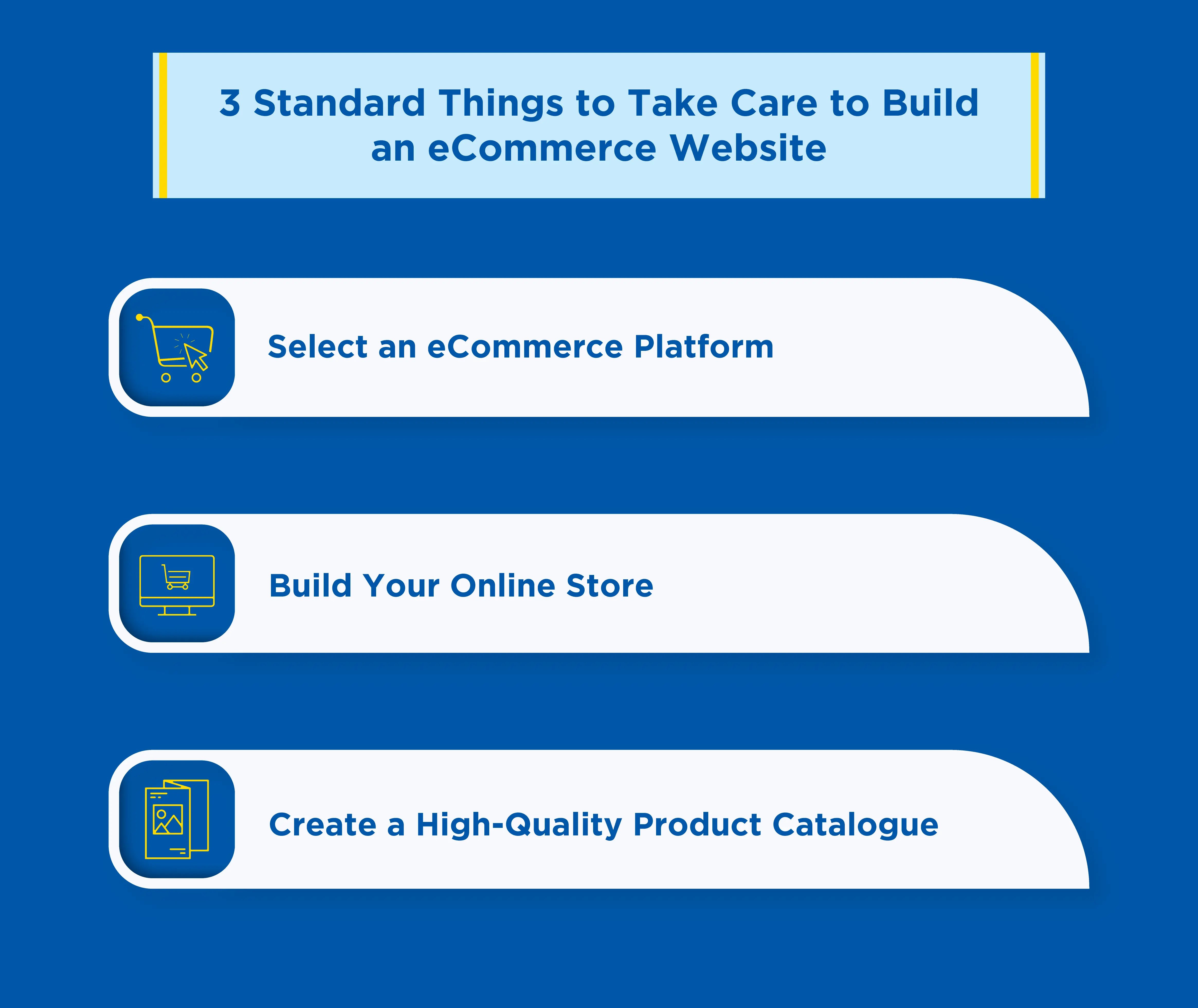
2.1 Select an eCommerce Platform
Before you start building your eCommerce store, it is crucial to determine what kind of platform you’d like to build it on.
While there are a plethora of marketplaces out there that let you start selling your products online immediately.
But as we discussed in the beginning, most marketplace platforms allow limited flexibility & scalability. So, it’s best to build an eCommerce website of your own if you’re in it for the long term.
Currently, Magento, Shopify, and BigCommerce are the most popular eCommerce platforms. However, which eCommerce platform is right for your business mostly depends on your long-term goals & targets.
For example, a business in its early stage does not need the platform same as a business in a growth stage.
So, start by creating a list of your requirements to gain clarity on what kind of eCommerce platform would be the right fit for you.
2.2 Build Your Online Store
Once you’ve decided what products to sell online and which platform to build your eCommerce store upon, you’re now ready to start building your online store.
At this stage, if you’re confused about how to get started with building your online store, you don’t need to worry. Even if you don’t have technical expertise or resources at your disposal to build an eCommerce website from scratch, you can still develop an intuitive online store on your own.
Many eCommerce platforms now allow building beautiful online stores without having to write a single line of code.
SaaS platforms like Shopify, BigCommerce, and WooCommerce give you all the tools you need to design and develop your eCommerce store, upload your product catalogue, and market your products on the internet.
2.3 Create a High-Quality Product Catalogue
A product Catalogue is critical in grabbing potential customers’ attention and generating sales in an eCommerce business.
If you’re just starting your eCommerce business, chances are you might not have a professional photographer and copywriter at your disposal.
In this case, here are some tips to create a high-quality product catalogue by yourself.
Images
If you’re going to click product images on your own, the first thing you need to know is that you don’t have to buy the best or most expensive camera equipment. Today’s smartphones already come with good quality cameras that can take amazing photos.
Ideally, your images should be able to accomplish two goals: Make your products look desirable & align with your brand image.
Here are a few tips to keep in mind for achieving these two goals.
- Bright Lighting - Use bright lighting, move your products close to them, or simply leverage natural lighting to get the best shots. If any of your products are smaller in size, we recommend investing in a good quality light box.
- Levelling - Instead of clicking pictures of your products from above, get it down to eye level and click a few close-up shots.
- Highlight Details - It’s not necessary to frame the entire product in every photo. Instead, you should click photos from different angles to cover all details and show why customers should want this product.
- Click Lots of Photographs - Try using different cameras or smartphones and click photos from different angles and using different lighting. Remember, even professionals take hundreds of shots to get that one perfect photo.
Description
Ideally, your product descriptions should be easy for busy people to digest in one glance.
Here are a few tips to keep in mind for achieving that goal:
- Leverage the Headline Space - Use descriptive product names to tell your customers (and search engines) exactly what a product is. For instance, instead of writing Navy Blue Jeans, be more specific like Navy Blue Slim Fit Stretchable Jeans for Men.
- Nail the Overview Part - When writing the overview of your products, aim to tell your potential buyers why they should care about this product & how it fulfils their needs in a sentence or two.
- Use Short Paragraphs - Most people nowadays click away when they see a big wall of text. So, when writing product descriptions, aim to write 4-6 short paragraphs that explain the main USP of your products.
- Make Details Easily Digestible - Instead of writing paragraphs, try to use bulleted lists to make them look more readable & digestible.
3. Promote Your Products
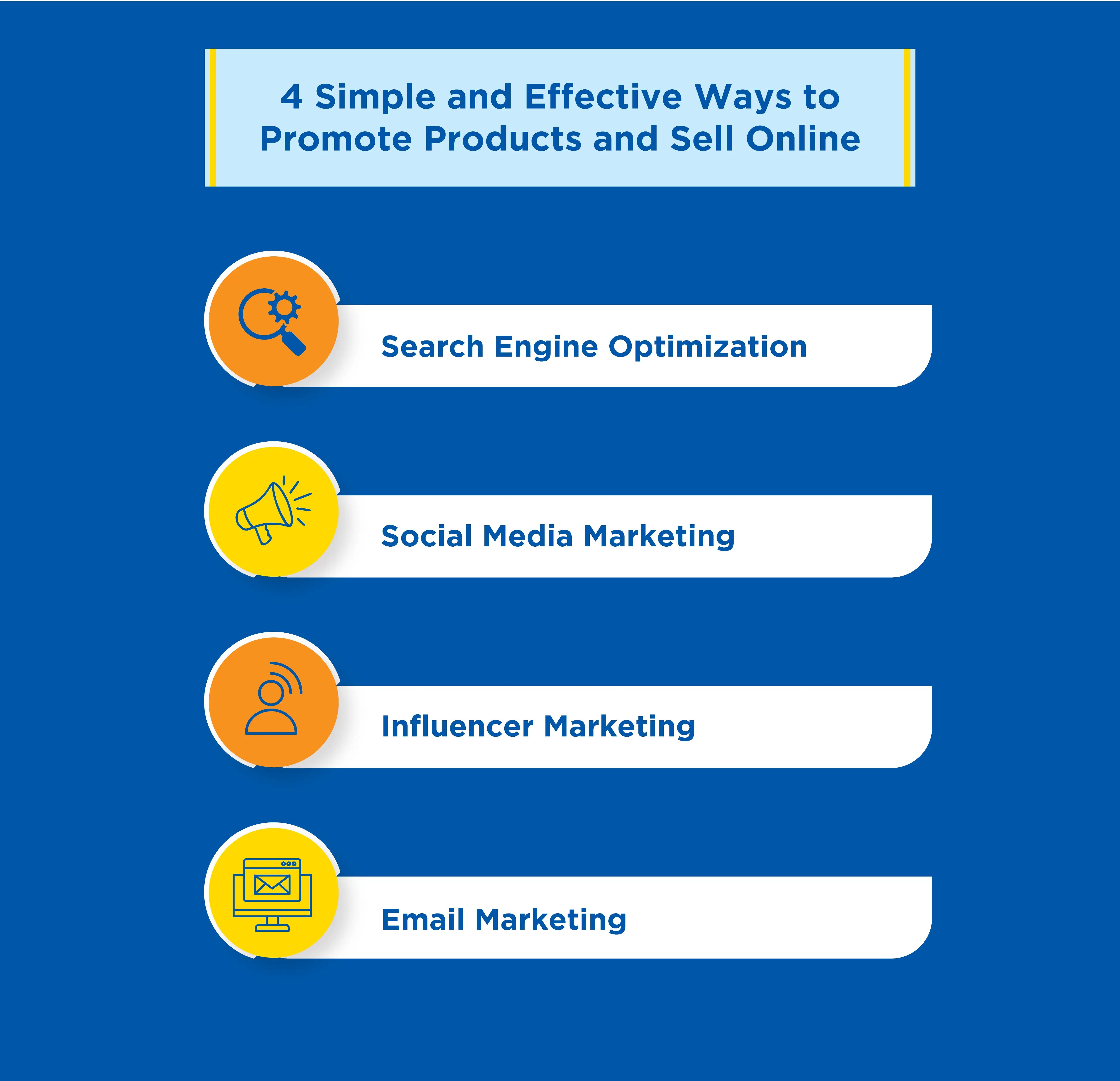
There are plenty of ways to promote your products and get them in front of potential customers.
Below, we will discuss the top online channels to promote your products online.
3.1 Search Engine Optimization
Search Engine Optimisation (SEO) comprises many practices, and trying to do it all at once can easily lead you down a deep rabbit hole.
If you’re just starting out with SEO for selling your products online, here are a few things to keep in mind.
On-Page Content
On-page content basically refers to product titles, overview descriptions, blogs, images, landing page content, or any other content you might have published on your eCommerce site. Ideally, you should produce & publish content that naturally uses language the majority of your customers are using to search for products similar to yours.
Meta Tags
Meta tags are an important aspect of SEO. Title tags, for instance, act as headlines for search engines to determine what each webpage is about on your eCommerce site.
Meta descriptions, on the other hand, are equally crucial in SEO. For the uninitiated, meta descriptions are short overviews of your web pages. Whenever a user types a search query, title tags and meta descriptions are the first two things they see on search engine result pages before anything else.
3.2 Social Media Marketing
When you’re starting an eCommerce business, you’ll want to take every opportunity that boosts your online engagement & eCommerce sales.
Of all the marketing channels, social media is one of the easiest ways to increase your online engagement as well as sales.
So once you’ve signed up on the popular social media platforms, keep your profiles regularly updated with vibrant, attention-grabbing images, encouraging videos, and persuasive content.
Apart from that, you can also increase your engagement and sales by hosting giveaways, announcing sales for your social media followers, and working with influencers in your niche.
This brings us to the next point…
3.3 Influencer Marketing
Influencer marketing has gained immense popularity in the last few years. For the uninitiated, influencers are internet celebrities who have garnered a massive following on social media platforms.
Partnering with influencers in your industry can be incredibly profitable since they have the power to influence the purchasing decisions of their followers (a.k.a your potential buyers).
To make the best of influencer marketing, aim to find influencers whose followers align with your target customers and utilise various tactics to get your products in front of a massive number of potential buyers.
Some of the best influencer marketing tactics you can use include having them write a blog post about your product, post unboxing videos of your products, or write social media review posts for your products.
3.4 Email Marketing
Email marketing is one of the most effective ways to target your potential buyers and increase your product sales online.
If you’re utilising email marketing for the first time, one of the first things you need to know is that most customers are generally interested in how buying your product(s) can benefit them.
Another surefire way to convert potential buyers into paying customers is by offering discounts or offers to first-time buyers. Doing so can drastically increase the chances of making sales.
For returning customers, you can consider introducing a loyalty program or announcing an exclusive sale, especially for them.
4. Receiving & Processing Orders
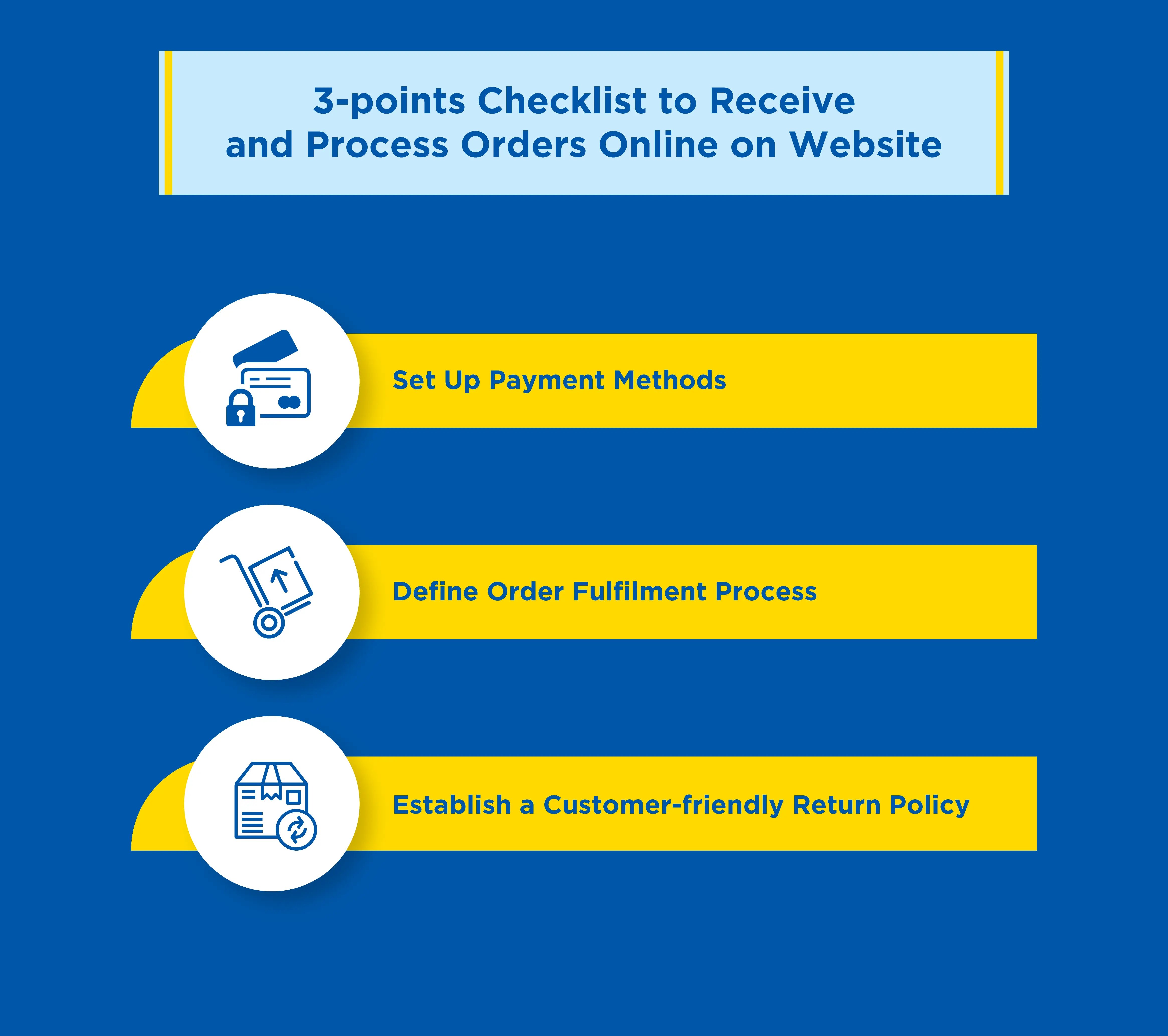
Launching an eCommerce business is always exciting.
But before you can start selling your products online, you’ll need to place proper systems in place for collecting payments and shipping products to your customer's doorsteps.
4.1 Set Up Payment Methods
Setting up payment methods is one of the most important parts of the eCommerce business. After all, your entire business revolves around getting paid.
Moreover, the demand for online transactions is growing rapidly all around the world.
As per WorldPay’s latest report, online payment methods such as bank transfers, credit cards, and e-wallet transactions are forecasted to grow from 65% to 72% by 2023.
This shift in payment preferences is pushing eCommerce businesses to start offering a variety of online payment methods to meet the demands of their customers.
Furthermore, by offering multiple payment methods, eCommerce businesses make the checkout process seamless for their customers. And the better the user experience you provide, the higher the chances of turning one-time buyers into regular customers, leading to more sales.
4.2 Define Order Fulfilment Process
Unless your eCommerce business sells strictly digital products, you’ll need to establish a proper order fulfilment process to get products to your customers within the expected time period.
Ideally, eCommerce owners rely on 3PL or eCommerce order fulfilment service providers to take care of this. But if you’re going to do it in-house, then you need to be aware of the standard order fulfilment process.
The order fulfilment process mainly comprises the following 3 steps.
- Picking Orders - As soon as the customer has made the payment & order is received, the order fulfilment process is initiated. At this stage, your warehouse staff receives order information, picks up the order from the inventory, and brings it to the packing station.
- Packing Orders - Once the items of the order arrive at the packing station, the staff member will inspect certain aspects of the item such as weight, fragility, physical size, etc. to determine the best packing material, and start packing the order to be shipped.
- Shipping Orders - After the order is packed, all that’s left to do for your warehouse staff is to print out the shipping label, select an appropriate shipping option, and forward it to the partnered carrier company.
4.3 Establish a Customer-friendly Return Policy
Product return requests can be painful both emotionally & financially. But they’re an inevitable part of an eCommerce business.
There are plenty of reasons why customers request a product return. It could be because the product arrived damaged, the wrong size was ordered, or the quality of the product simply didn’t meet their expectations.
Whatever the reason may be, having a customer-friendly return policy is absolutely critical for turning a negative experience into a somewhat positive one.
In fact, a UPS study also discovered that 62% of online shoppers often check an eCommerce site’s return & exchange policy before placing their orders.
This is the primary reason why many eCommerce brands have started using words like “free”, “no-hassle”, and “easy” in their return policy to increase sales.
Ideally, you should strive to make the product return & exchange process as hassle-free as possible by introducing a simple, straightforward, and customer-friendly return policy.
Other Platforms to Leverage for Selling your Products Online
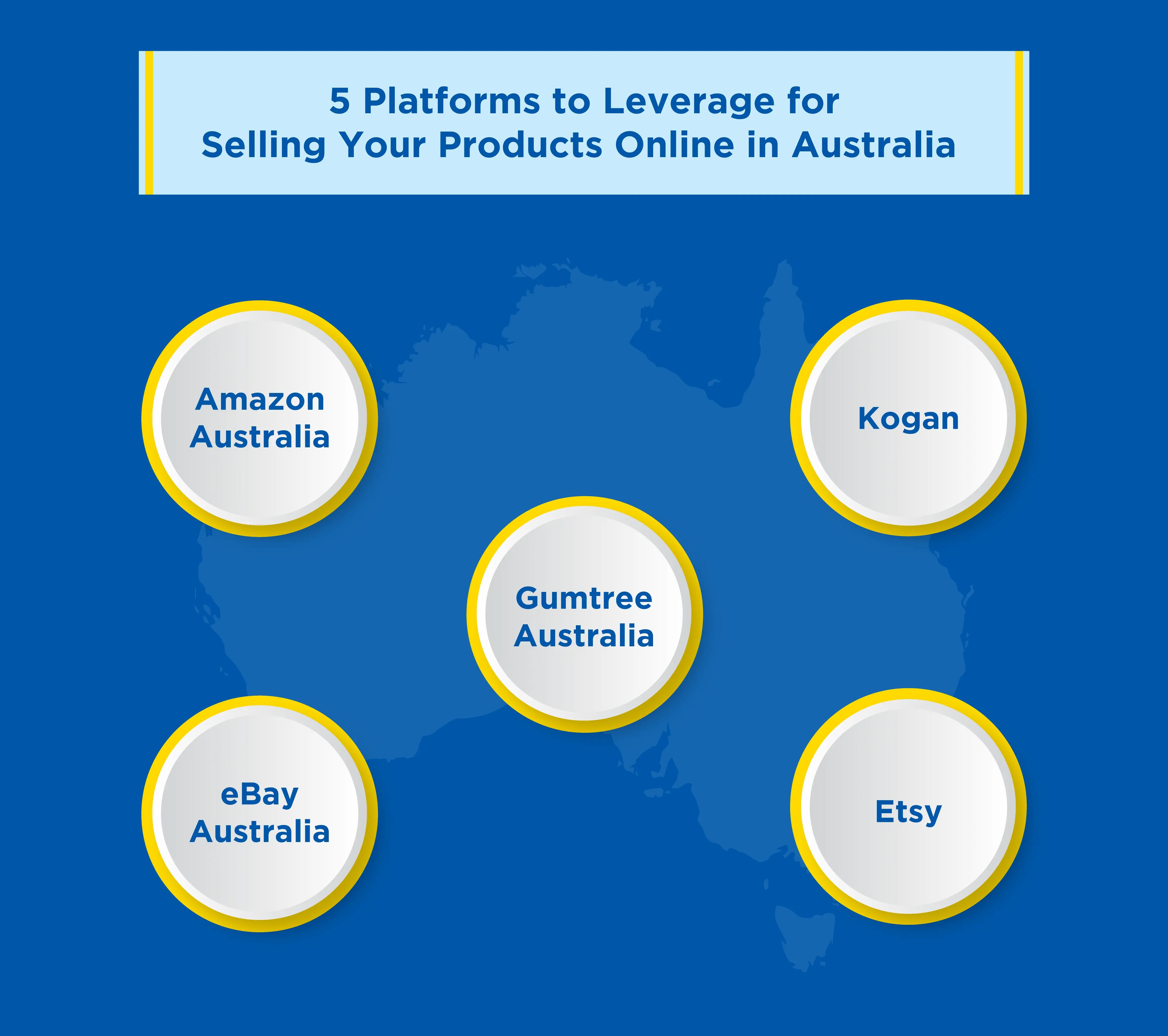
Now that we’ve covered everything you need to know to start selling your products online through an eCommerce store of your own, it’s finally time to discuss the marketplace option as we promised.
Other than your website, you can leverage platforms like online marketplaces and social commerce platforms listed below to start selling your products online.
Amazon Australia
Amazon was first launched in the US back in 1994 and it rapidly became a leader in the eCommerce space.
It provided a platform for local businesses to become online sellers and consumers to gain access to a massive range of products from all around the world.
While Amazon had already started shipping products to Australia quite a few years ago, it only set up its physical presence later in 2017.
Despite operating in the country for only five years, Amazon Australia has already become the third largest eCommerce marketplace in the country with 28.80 million estimated monthly visitors.
eBay Australia
eBay was the first ever eCommerce marketplace to enter the Australian market back in 1999.
Since then, eBay Australia has successfully established itself as one of the leading marketplaces in the Australian eCommerce industry with over 68 million estimated monthly visitors.
Today, eBay Australia allows individuals & businesses to sell directly on the platform using both methods — auctions & immediate sales.
Gumtree Australia
Gumtree is a UK-based marketplace & classified site that entered the Australian eCommerce market in 2007. Soon after its arrival, Gumtree quickly climbed to become one of the leaders in the online marketplace category.
Today, millions of Australians browse Gumtree Australia marketplace to buy and sell goods as well as services on the platform.
The most popular categories of Gumtree Australia include apparel, home and garden, accessories, real estate, and more.
Kogan
Launched in 2006, Kogan.com is an Australia-based, online marketplace that began as a pure-play eCommerce site.
It spotted an opportunity to sell consumer electronics online when no other pureplay eCommerce sites existed in the country.
It started selling TVs and eventually expanded its offerings to other consumer electronic products. In 2016, Kogan.com even acquired Dick Smith, an Australian Electronics Retailer, to strengthen its footprint in this category.
Today, Kogan.com has transformed itself into a marketplace platform where you can sell a wide range of products from different categories including furniture, baby and kids, office supplies, and more.
Etsy
Etsy is a niche marketplace for artists and creatives and is ideal for selling custom-made, hand-crafted, vintage products.
Etsy also caters to merchants who sell digital products such as website themes, ebooks, and so on.
Etsy allows you to create your own digital shop on the Etsy marketplace. And the best part? — you can easily build your shopfront on Etsy without any technical background, knowledge, skills, or experience.
However, one thing you need to keep in mind as an Etsy seller is that the platform charges transaction fees for every sale you make. In addition, Etsy also charges Paypal fees which are directly deducted from your overall profit.
Considering this, it may be a good idea to not rely on Etsy for selling your products online and consider building an online store of your own.
Summary
As you can clearly tell, setting up your eCommerce store may require a bit of effort. But following these steps are easily manageable if you take them one at a time.
More importantly, once you’ve taken care of that initial set-up process, you’re going to find eCommerce worth your while.
With that, we hope you’ve now finally learned how to start selling a product online via both, the eCommerce option and the marketplace option.
Good luck & happy selling!
